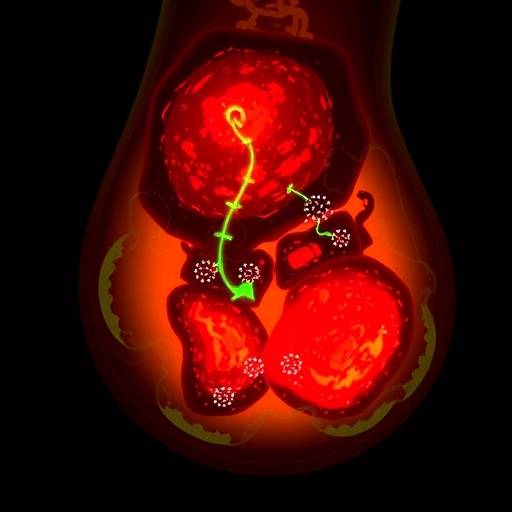In a groundbreaking study shedding new light on the intricate molecular pathways driving gouty arthritis (GA), researchers have unveiled how post-translational modification of a key ubiquitin ligase exacerbates disease progression by regulating a previously underexplored form of programmed cell death known as pyroptosis. This discovery not only deepens our understanding of gout’s inflammatory processes but also opens up promising avenues for targeted therapies aimed at halting or reversing this debilitating condition.
Gouty arthritis, a widespread inflammatory disease characterized by severe joint pain and swelling, has long posed a challenge to clinicians due to its complex etiology and limited effective treatment options. At the core of its pathology lies the uncontrolled inflammation triggered by monosodium urate crystal deposition in joints, which activates innate immune responses. However, the precise molecular cascades orchestrating these inflammatory responses are still being elucidated, making studies like this one critically important.
The recent investigation centers on NEDD4, an E3 ubiquitin ligase that plays a pivotal role in protein degradation and cellular signaling pathways. Researchers found that NEDD4 undergoes a specific chemical modification known as S-nitrosylation at the cysteine residue 365 (C365). This modification critically alters NEDD4’s function, inhibiting its ability to tag its substrate NOD1 — a pattern recognition receptor — for ubiquitination and subsequent degradation. As a result, NOD1 accumulates within the cell, driving inflammatory cascades that fuel GA’s progression.
.adsslot_dWzeI0MHtQ{ width:728px !important; height:90px !important; }
@media (max-width:1199px) { .adsslot_dWzeI0MHtQ{ width:468px !important; height:60px !important; } }
@media (max-width:767px) { .adsslot_dWzeI0MHtQ{ width:320px !important; height:50px !important; } }
ADVERTISEMENT
NOD1, traditionally recognized for its role in detecting bacterial components and mediating innate immune responses, emerges from this study as a crucial regulator of pyroptosis — a highly inflammatory form of programmed cell death distinct from apoptosis and necrosis. Through its activation, NOD1 instigates the assembly of molecular complexes including NLRP3, ASC, and caspase-1, all instrumental in cleaving gasdermin D to its active GSDMD-N form, which perforates the plasma membrane and facilitates the release of pro-inflammatory cytokines such as interleukin-1β (IL-1β) and interleukin-18 (IL-18).
The implications of these findings are profound, as they illuminate novel molecular targets for therapeutic intervention in GA. Specifically, strategies aimed at preventing NEDD4 S-nitrosylation or enhancing NOD1 degradation could attenuate pyroptosis-driven inflammation, offering relief to millions of patients worldwide suffering from this chronic disease. Importantly, the study pioneers in establishing the expression profiles of both NEDD4 and NOD1 in GA, filling a critical knowledge gap in gout research.
This study’s revelation that S-nitrosylation, a reversible yet impactful post-translational modification, can modulate ubiquitin ligase activity adds a new layer of complexity to our understanding of protein regulation under inflammatory stress. It highlights the delicate balance cells maintain in controlling protein stability and immune responses, emphasizing how dysregulation at this level can ignite pathological inflammation.
Moreover, by connecting NOD1 to the activation of the NLRP3 inflammasome pathway, the research integrates several previously disparate molecular threads in GA pathophysiology. The NLRP3 inflammasome has been extensively studied for its role in sensing danger signals and coordinating immune responses, yet the mechanisms controlling its upstream activation have remained somewhat elusive. Here, the stabilization of NOD1 emerges as a crucial upstream event, providing new mechanistic insights.
Clinically, these findings suggest that biomarkers reflecting NEDD4 S-nitrosylation status or NOD1 abundance could serve as diagnostic indicators of GA severity or therapeutic response. Furthermore, pharmacological agents capable of modulating iNOS activity or interfering with the S-nitrosylation process hold promise as novel therapeutic candidates.
Further exploration into the signaling interplay between nitric oxide signaling, ubiquitin-proteasome pathways, and inflammasome activation promises to unravel additional layers of immune regulation pertinent not only to gout but potentially other inflammatory diseases as well. The study’s robust experimental design, spanning molecular biology, immunology, and animal modeling, lends significant weight to its conclusions.
Importantly, this research signifies a paradigm shift in how we conceptualize gout’s inflammatory mechanisms, moving beyond uric acid crystallization alone toward a more integrated view involving post-translational modifications and programmed cellular demise. This broader framework may ultimately revolutionize treatment strategies and improve patient outcomes.
As the prevalence of gout continues to rise globally, driven by aging populations and lifestyle factors, harnessing insights from studies like this will be pivotal in addressing unmet clinical needs. The capacity to target molecular switches such as NEDD4 S-nitrosylation could herald the arrival of precision medicine approaches tailored to interrupt pathological inflammation at its source.
In summary, the elucidation of S-nitrosylated NEDD4’s role in stabilizing NOD1 and consequently triggering NLRP3-dependent pyroptosis represents a significant advance in the understanding of gouty arthritis pathogenesis. This research not only contributes foundational knowledge but also charts a clear course toward innovative therapeutic interventions aimed at mitigating disease progression by modulating protein post-translational modifications and innate immune signaling.
The insights gained from this work are anticipated to galvanize further studies exploring the molecular intricacies of pyroptosis and ubiquitination in inflammatory diseases. Ultimately, leveraging the mechanistic revelations surrounding NEDD4 and NOD1 may transform the therapeutic landscape for gout and potentially other inflammasome-related disorders, offering hope for improved care and quality of life for affected individuals worldwide.
Subject of Research: Molecular mechanisms underlying gouty arthritis progression through regulation of pyroptosis by S-nitrosylated NEDD4 and NOD1 signaling.
Article Title: S-nitrosylated NEDD4 exacerbates gouty arthritis by upregulating NOD1 to induce pyroptosis.
Article References:
Qu, X., Wang, Q. & Qiu, H. S-nitrosylated NEDD4 exacerbates gouty arthritis by upregulating NOD1 to induce pyroptosis. Genes Immun (2025). https://doi.org/10.1038/s41435-025-00341-7
Image Credits: AI Generated
DOI: https://doi.org/10.1038/s41435-025-00341-7
Tags: cellular signaling pathways in arthritischronic inflammatory conditionsgouty arthritis mechanismsinflammatory disease researchjoint pain and swellingmolecular pathways in gouty arthritismonosodium urate crystalsNEDD4 and inflammationprogrammed cell death pyroptosisS-Nitrosylated NEDD4targeted therapies for goutubiquitin ligase function





